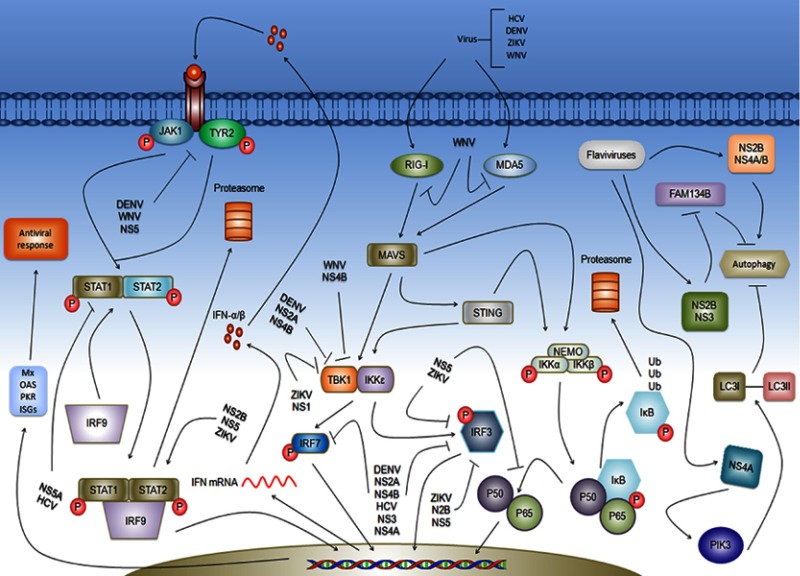Figure 4.
Antiviral response and immune escape mechanism triggered by hepatitis C virus (HCV) and flaviviruses DENV, ZIKV, and WNV. Among PRRs, RLRs are extremely important in development of antiviral responses mainly associated with actions of IFN-α and β. Among the receptors, we highlight RIG-I and MDA5 that recognize PAMPs either HCV or flaviviruses to activate MAVS and STING, which in turn, provoke the formation of TBK1/IKKε and NEMO/IKK-α/β complex. This mechanism has the final product for both phosphorylation of IRF7 and IRF3 and the release of KF-κB p50/p65 subunit that migrates to the nucleus to activate genes responsible for production of inflammatory cytokines and IFN-type 1. In the case of IFN-α and β, IFNR activation recruits JAK1 and TYR2, which when phosphorylated, trigger formation of an intracellular cascade that culminates in formation of the STAT1/STAT2/IRF9 complex, which migrates to the nucleus, activating genes associated with the antiviral response such as Mx, OAS, PKR, and ISGs. To evade the immune response, HCV or flaviviruses induce the production of non-structural proteins that inhibit response of several markers at points considered essential for the development of the intracellular cascade, facilitating the viral replication process. A priori WNV can establish primordial control of antiviral responses at the level of inhibition of RIG-I and MDA5. In another follow-up, ZIKV, DENV, WNW, or HCV through NS1, NS2A, NS2B, NS3, NS4A, NS4B, or NS5 inhibit TBK1/IKKε complex formation, IRF3 and 7 phosphorylation, and NF-κB activation. In the response by IFN-type 1, NSEN of DENV and WNV inhibited activation of JAK1/TYR2. HCV NS5A inhibits activation of STAT1 and 2. Among various immune escape mechanisms, autophagy is critical for flavivirus to mediate biogenesis of viral replication, mainly because of changes in pH and endocytosis. In this sequence, it is worth noting that NS2B and NS4A/B proteins can manipulate autophagy to alter membrane curvature in the Golgi apparatus to facilitate viral replication. However, in another follow-up, NS2B/3 cleaves FAM134B into endoplasmic reticulum (ER) to suppress autophagolysosome formation and reticulophage, a form of selective autophagy, to facilitate viral replication. As a result, NS4A induces cells to produce PIK3, which impair the conversion of LC3I to LC3II and inhibit autophagy.

